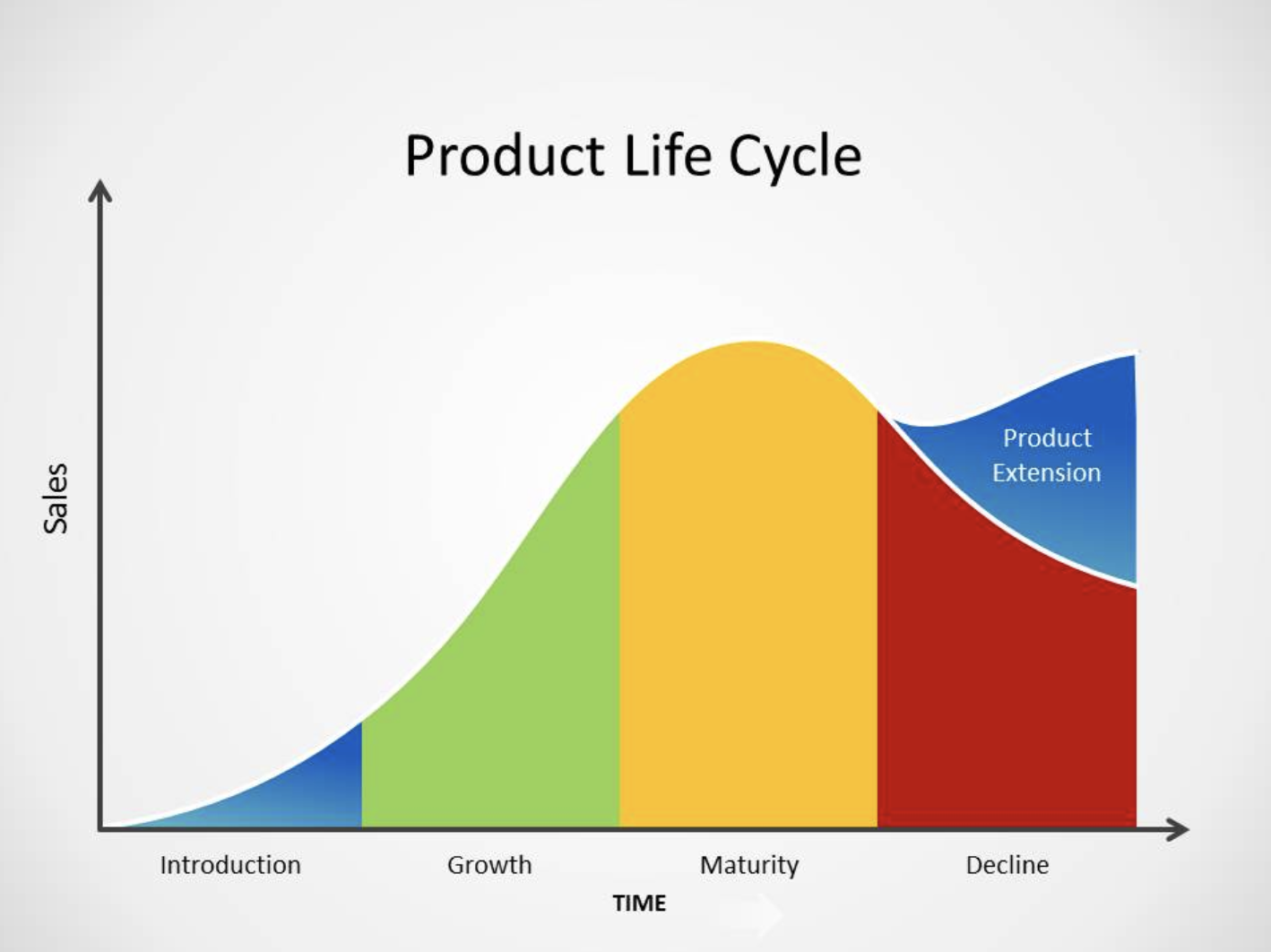Marketing
3.5 The seven Ps of the marketing mix
Product
TOOL: Product life cycle
- Outlines the different stages a product goes through
- Introduction: high investment, negative profitability and cash flow
- Growth: High investment, profitability increases but is likely still negative, cash flow is negative or close to breakeven point
- Maturity: Investment decreases, profitability is high, cashflow is positive
- Decline: Profitability, cashflow, and investment depend on the choice of whether the business will conduct an extension strategy

Limitation
- Not all products follow this "life cycle"
- Only looks at sales revenue of a single product; disregards businesses who have multiple products and the synergies between them
Extension strategy
- Avoids the decline of sales by further investing in a product
- Techniques used by a business to extend the life of a product beyond its natural life cycle
- Common examples: reduce price, promotional strategies, and enhance product (e.g., release a new iPhone every year)
Aspects of branding
- Branding is a marketing technique used to give a product or a business a unique name or identity
- It helps set a business apart from its competitors
- 4 types:
- Brand awareness
- Brand development
- Brand loyalty
- Brand value
Brand awareness
- How much people know and identify the brand by its branding and products
Brand development
- The result of the efforts to improve a company's branding
- Process of making people more attracted to the brand; an example of a consequence is increased sales
- Can be expensive
Brand loyalty
- When customers repeatedly and habitually buy from the same brand
- Helps prevent customers from switching to rival brands
- Main goal: retaining customers
Brand value
- Is an intangible worth attached to a brand perceived by the eyes of the market
Exam tip
Aspects of branding are topics which are almost always present in the stimulus provided by the IB (in questions). It is also a great theory that can be explored in Extended Essays and Internal Assessments.
Pricing
- Cost-plus (mark-up) pricing
- Adds a profit margin to the costs of production to determine the selling price of a good or service
- Simple to understand and use
- Ensures each sale makes a positive contribution
- Ignores prices set by competitors
- Does not consider consumers when setting price
- Penetration pricing
- Setting a low price to penetrate the market and gain market share
- Allows firms to compete against market leaders
- Easy entry to market
- Easy gain of brand recognition
- Increases market share
- Price advantage against competitors
- Not sustainable in the long run
- Consumers may view the product as bad quality due to cheap price
- Loss leader pricing
- Pricing a product below its cost of production to attract customers to purchase other items
- Helps attract customers
- Can increase sales of products
- Can be used to clear stock
- Helps penetrate the market
- If customers do not purchase other products the business makes a loss
- Expensive to offer in the long term
- Predatory pricing
- Set prices so low to drive competitors out of the market
- Business gains dominant position in the market
- Decreases competition
- Increases sales
- Attracts new customers
- Anti-competitive
- Consumers may view the product as bad quality due to cheap price
- Not sustainable in the long term
- Premium pricing
- Setting high prices on products so consumers associate it with high quality, luxury, and status
- Increases brand value
- Emphasizes exclusivity
- Improves sales
- Increases profit margins
- Increases trust in brand
- Can limit the pool of customers due to steep price
- High-quality products require expensive raw materials
- Customers can be angry if products do not match their high expectations
- Changing prices to match demand patterns of the market
- Prices are based on the willingness of customers to purchase the product or service at a specific time
- Maximize sales revenue
- Optimal use of resources
- Respond quickly to market trends
- Customers who are charged higher prices can feel that they are being "ripped off"
- Requires research to do so; expensive
- Company uses the prices the competitors are charging as a benchmark when charging their own
- Simple strategy
- Low risk
- Flexible
- Customers will likely see the pricing as fair
- Difficulty to stand out in a competitive market
- Collecting data on competitors pricing can be expensive
- If competitors pricing is too low the business may suffer losses when trying to match their prices
- Strategy that involves setting the price greater than the per unit variable cost of production of the products to ensure that a positive contribution is made towards fixed costs
- Straightforward
- Enables businesses to know how much profit the business will earn on each sale
- Requires company to have a good idea of their variable costs and have breakeven done so they can connect their contribution to profitability
- Ignores fixed cost when pricing product
- Assumes selling price is constant ignoring possible discounts
- Involves calculating if increasing the price of a product is better for revenue or if decreasing the price is better for revenue
- It measures how demand changes as pricing changes
- Companies use elasticity of demand to determine their pricing strategies
- e.g., an inelastic company can choose to change premium pricing as their customers are flexible with pricing
Dynamic pricing (HL)
Competitive pricing (HL)
Contribution pricing (HL)
Price elasticity of demand (HL)
Promotion
- Generates customer awareness, interest, and desire for products
- Can be classified into 3 types:
- Above the line
- Below the line
- Through the line
Above the line
- Advertising activities aimed at reaching a wide audience through mass media channels to create awareness about a product, service, or brand
- Examples: TV advertising, billboards, etc.
Below the line
- Marketing coordination over which a business has direct control and which does not make use of mass media
- Aimed directly at a target audience
- Examples: emails to customers, one-to-one sales, and interviews
Through the line
- Is a combination of above and below the line promotion strategies
- Examples: running a TV advertisement commercial followed by social media advertising and targeted emails
Exam tip
The IB often asks you to classify which type of promotion strategy was used in a certain stimulus so it is good to know some examples for each type of promotion
Social media promotion
- Use of online content to target promotional content at users of online communities
- Often uses platforms like Facebook and Instagram
- Both above and below the line promotion
- Wide reaching
- Cost-effective
- Content is easily shared among the audience
- Allows for the use of analytics
- Enables businesses to target specific market segments
- Requires consistency and effort to be successful
- Negative complaints (comments) can be viewed by other users
- Hard to stand out from the thousands of brands which also use social media promotion
Place
- Distribution channels: the chain of intermediaries through which goods/services move from the manufacturer to the end customer
- There are 3 common types of distribution channels:
- Four stage
- Three stage
- Two stage
Four stage
- Uses wholesaling and retailing
- Producer -> wholesaler -> retailer -> consumer
- Storage costs are absorbed by wholesaler
- Producer has more time to care for production
- Wholesaler and retailer increase price of product for consumers
- Reduces profit for producer
- Below the line promotion is not under control of the producer
Three stage
- Uses retailing
- Producer -> retailer -> consumer
- Customer service and promotional activities are carried out by retailer
- Helps attract large customer base
- Producer has more time to care for production
- Retailers often have high costs resulting in higher prices
- Below the line promotion is not under control of the producer
Two stage
- Producer-> customer (B2C)
- Low cost
- Fast way to get products to the customer
- Producer has full control of promotional strategies used
- Business keeps 100% of sales revenue
- Storage and distribution costs are the responsibility of the producer
- Customer service issues can disrupt production
- Promotional activities are the responsibility of the producer
People
- They are the people who interact with customers and deliver the service
- Customer service is crucial for customer satisfaction
- They have customer interactions and help by selling services and providing feedback on products being sold (e.g., identifying trends)
Processes
- The way in which a service is provided or delivered to customers
- e.g., queue systems in amusement parks, refund policies, and managing customer feedback
- Essential for customer satisfaction
Physical evidence
- The tangible and visible signs of a product or service that a customer sees and interacts with during their buying experience
- Examples: sounds in shop, packaging, and display signs
- Helps shape customer's perspectives and build trust and comfort

